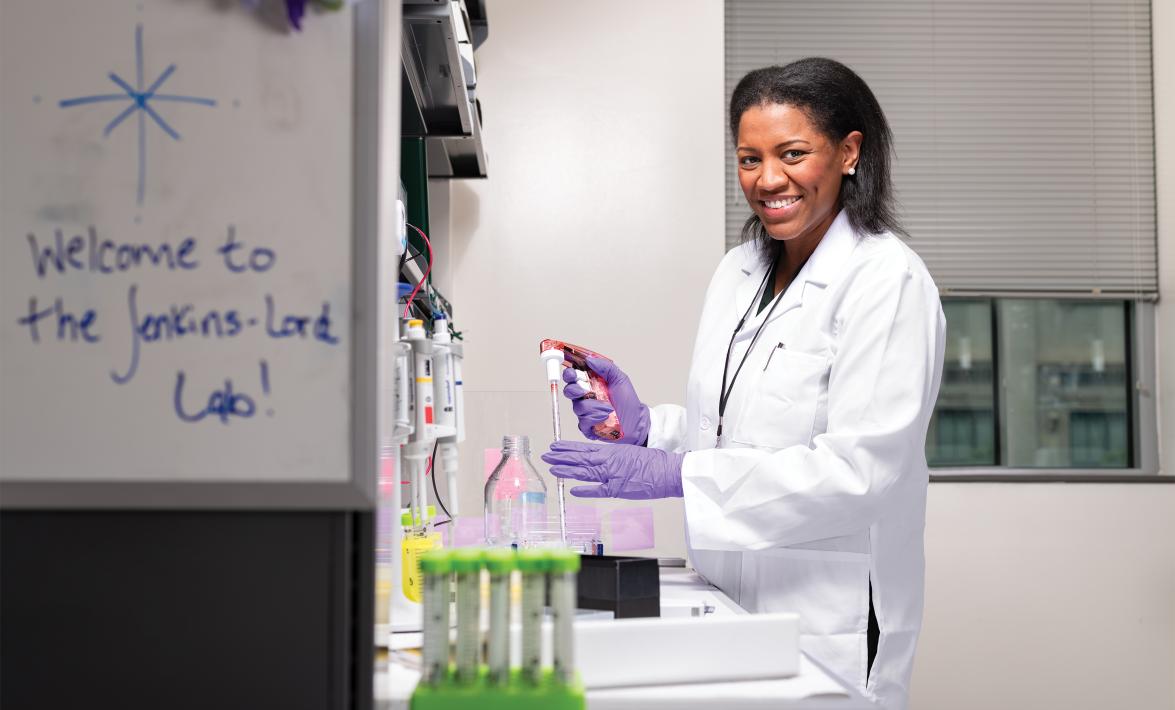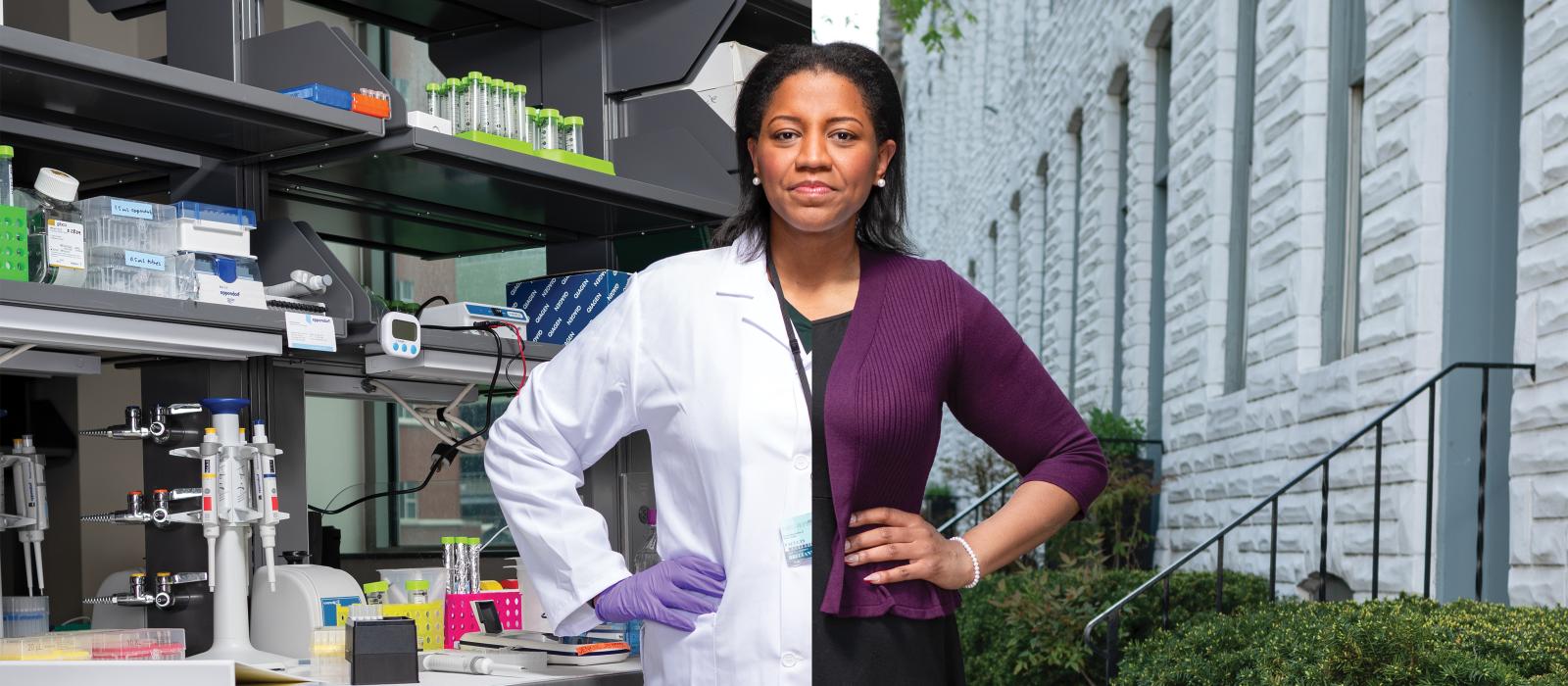This article discusses the work of Brittany Jenkins-Lord, PhD, MS, MPH, a 2023 Building Interdisciplinary Research Careers in Women’s Health (BIRCWH) Scholar
Brittany Jenkins-Lord seeks clues in the lab and the community to understand the biological causes of cancer disparities.
Soon after Brittany Jenkins-Lord came to the Bloomberg School in 2019 for her MPH, she often sat at a table at the front door of Baltimore’s Northeast Market. She was volunteering for a community-based project.
“When people walked in, we asked them, ‘Do you know about your family history? Would you like to learn how you can talk to your family about your health?’” she says.
Jenkins-Lord helped women chart their family histories in relation to disease risk and urged them to share the information with their doctors. Many had family histories similar to her own.
Growing up in Charleston, South Carolina, Jenkins-Lord, PhD, MPH ’20, MS, lost several family members to cancer who also suffered from diabetes, high blood pressure, obesity, and other comorbidities. It’s a narrative shared by many Black families in the South, where “there’s a lot of disease and a lot of risk factors for disease,” she says.
She was in her early 20s when her mother needed a hysterectomy as treatment for cancerous polyps in her uterus. A few years later, her mother developed a chronic cough that doctors discovered was caused by a metastatic tumor in her lungs. Surgeons removed the tumor, and her mother has since been cancer-free. But the impact on Jenkins-Lord was permanent.
Now an assistant professor in Biochemistry and Molecular Biology, Jenkins-Lord is investigating the interplay of molecular, genetic, environmental, and social contributors to breast cancer risk in African American women. It’s work that combines basic science and epidemiological approaches in new and powerful ways, fueled by collaborations across departments and with the community.
UNIQUE VARIANTS—AND RISKS
Though Black and white women have similar breast cancer incidence rates, Black women are more than 40% more likely to die from the disease. They develop more aggressive breast cancer tumors and are diagnosed younger.
Epidemiologists have associated environmental factors such as neighborhood deprivation, exposure to pollutants, and racism with more aggressive tumors and higher breast cancer mortality for Black women, as Jenkins-Lord lays out in a 2022 Cancer Causes & Control review. But discerning why these factors are more lethal to Black women requires looking beyond race to ancestry.
Race is a social construct based on physical characteristics, while ancestry refers to shared genealogical lineage. Genetic variations based on ancestry have been linked to disease. For example, sub-Saharan African, Mediterranean, and Saudi ancestry, among others, have been linked to the development of sickle cell disease. Similarly, molecular biologists have found that certain genetic variants linked to breast cancer occur more frequently in women with West African ancestry, the lineage shared by most Black women in the U.S. The researchers also identified variants unique to women of African ancestry. But only recently have scientists—including Jenkins-Lord—begun researching how environmental and genetic factors interact to cause greater mortality among Black women.
“Making connections between environmental exposures and cancer has been done for probably a century now,” Jenkins-Lord says. “You have your risk, you have your outcome, but in the middle, you have everything biological that’s happening. That’s the part I am focused on understanding more.”

A MORE COMPLETE GENOMIC BLUEPRINT
Starting in 2014, during her doctoral studies at the University of Georgia, Jenkins-Lord explored the genetics guiding immune response in Black women with triple negative breast cancer (TNBC), an aggressive cancer.
TNBC cells lack the three receptors that respond to hormone therapies that are effective for other types of breast cancer. She worked in the lab of cancer geneticist Melissa Davis, PhD, now director of the Institute of Translational Genomic Medicine at Morehouse School of Medicine.
Women with West African ancestry have twice the risk of developing TNBC and are more likely to die from it than women of European ancestry. The big question is why—but scientists don’t have all the tools they need to find the answer.
The problem is that African ancestry is less represented than European ancestry in parts of the human genome scientists have sequenced. Scientists need more genetic information from women with African ancestry to analyze, Davis says.
“We haven’t truly interrogated the reality of a patient’s genome when the reference, the blueprint we’ve been using, is completely devoid of that genetic information,” Davis says. “It’s like trying to assess what’s wrong with the plumbing in a house when there are two rooms completely missing from the blueprint.”
To fill in the genomic blueprint, Jenkins-Lord and Davis worked with Lisa Newman, MD, MPH, chief of breast surgery at Weill Cornell Medicine, to map more genetic profiles of TNBC patients with African ancestry, using donated tissue from patients in Ghana that Newman and her clinical team treated for breast cancer.
From these samples, the researchers gained insights into how the immune cell landscape of women with TNBC is shaped by ancestry. In a 2022 study in Cancer Discovery, they found that higher immune cell counts were correlated with a greater degree of quantifiable African ancestry. The discovery could have implications for new immunotherapies for TNBC that would be more effective for patients with West African ancestry.
In another cohort, Jenkins-Lord, Davis, and Newman found in a 2019 study in Cancer Epidemiology, Biomarkers & Prevention that DARC—a gene that regulates inflammation, a key driver of cancer—is more often suppressed in people with sub-Saharan African ancestry. Physicians may eventually be able to measure DARC expression in patients to create more effective treatment plans.
These insights were significant and valuable, but Jenkins-Lord’s motivating question of why breast cancer disproportionately kills Black women in the U.S. remained unanswered. As she continued to read papers on cancer disparities and genetics, she noticed that researchers usually wrote that their findings were controlled for socioeconomic factors.
“That was always the only mention of these factors. It was such an afterthought,” she says. “I remember thinking, what are these factors? How do they influence the biology of cancer disparities, and how can you control for all of them?”
Jenkins-Lord started to dig into those questions as a postdoctoral Cancer Prevention Fellow at the National Cancer Institute. The program included the opportunity to earn an MPH.
“In less than a year, I went from a basic science perspective of cancer into public health and looking into environmental risk factors for cancer,” Jenkins-Lord says.
BASIC SCIENCE LEAVES THE LAB
Research tying breast cancer disparities to environmental influences on biology is nascent, but Jenkins-Lord is quickly advancing the science. She is now working to uncover the epigenetics—changes in how genes are expressed or to what degree—behind breast cancer in Black women. She wants to know how factors such as pollution, poverty, and systemic racism interact with the biology of women with African ancestry to cause health disparities.
In a 2023 study in JAMA Network Open, Jenkins-Lord and collaborators showed that Black women living in disadvantaged neighborhoods may be more susceptible to breast cancer. The researchers analyzed donated breast tissue from 187 women who underwent surgery for breast cancer in Baltimore hospitals. They found that two cancer suppression genes were frequently expressed at lower levels in Black women who lived in disadvantaged neighborhoods—an epigenetic change that allows mutated cells to spread uncontrollably as cancer. Those genes were not affected in white women in those same neighborhoods.
The next steps are to determine “what upstream is molecularly causing the differences in gene expression we see in the Black population,” Jenkins-Lord says.
Jenkins-Lord is also collaborating with Avonne Connor, PhD, MPH, an associate professor in Epidemiology, to design a study that would link ancestry, neighborhood-level disparities such as food insecurity, and structural racism to breast cancer in Black women who were recently diagnosed.
“Looking at the epidemiology for risk and lifestyle factors and linking those aspects to assays Brittany will do for DNA methylation [epigenetic changes] would be novel for a large study,” Connor says.
The pair plan to create a study participant questionnaire that includes social and environmental determinants of health in order to connect external factors to immune-related gene expression in these women. “We would ask participants about their food security, housing stability, transportation issues—factors that could be important to investigate with the biological associations Brittany is interested in,” Connor says.
Figuring out more about why Black women are more likely to die from breast cancer is “going to take a generation of scientists” trained in both epidemiology and molecular biology, Jenkins-Lord says. “Scientists need to understand both sides of that coin: What’s going on genetically and in our environment.”
And to do that, she says, scientists have to get out of the lab. “I want basic scientists to consider the community and environment.” she says. “Talking to people was one of the most impactful things during my MPH.”
This simultaneous pursuit of epidemiology and genetic studies makes Jenkins-Lord a leader in this new generation of cancer researchers.
Ashani Weeraratna, PhD, Bloomberg Distinguished Professor and chair of Biochemistry and Molecular Biology, says she sees great power and potential in Jenkins-Lord’s ability to combine those disciplines: “When I recruited Brittany, it was because she represents the future of BMB—a true pairing of basic science with public health.”
Article by Leah Small | Hopkins Bloomberg Public Health Magazine
Images by Mike Morgan

